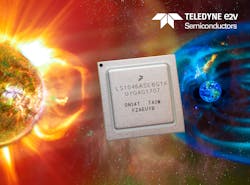Teledyne e2v’s Latest Services Address Thermal & Power Constraints in Mil/Aero Applications
Teledyne e2v has improved their ability to address power and thermal constraints in Hi-Rel electronic platforms. Building on services initially announced in late 2019, the company is now expanding the scope of these services to encompass several key additional elements. Consequently, multifaceted services are now available to design teams for increasing design margins when implementing high-performance multi-core processors.
Faced with issues of power management and the room needed to dissipate generated heat, engineers must find ways to enhance their designs accordingly. Services start at the conception phase, where the customer’s technical team has the opportunity to better assess design margins at the processor level. This will help them to understand what particular confines must be kept within. Teledyne e2v’s skills and experience in processor usage offer multiple opportunities for improving power and/or thermal performance on processor-based systems
Through in-depth analysis of the system’s overall behavior, it is possible to define the best approach to overcome potential challenges posed by keeping to a limited available power budget, as well as those relating to space saving measures. Data on parameters like processor CPU load, core frequency and junction temperature can be consulted in order to do this. Following on from that, Teledyne e2v’s ability to screen and deliver power optimized processors means that units can be supplied that are an optimal fit with the defined criteria. Heightened performance benchmarks can thereby be achieved, while still conserving power resources and minimizing heat generation.
Rad-Tolerant Space Processor Passes 100krad TID Testing
Teledyne e2v also announced that its LS1046-Space processor passed stringent total ionizing dose (TID) radiation tests, achieving 100krad resilience. This multi-core device, which features four 64-bit Arm Cortex-A72 processing cores, was able to operate as normal after the TID tests had been undertaken. These results complement those previously obtained in terms of single event latch-up (SEL) and single event upset (SEU) when exposed to heavy-ions up to more than 60MeV.cm²/mg.
Running at operating frequencies of up to 1.8GHz, Teledyne e2v LS1046-Space is based on NXP processor technology. It has a built-in 64-bit DDR4 SDRAM memory controller with 8-bit error corrected code (ECC), plus a 2MByte L2 cache shared across its cores. L1 and L2 caches are both ECC-protected, so as to offer a high degree of immunity to data corruption. This high-reliability processor is supplied in a 780-ball BGA package and comes with a wide range of interfaces embedded - including 10Gbit Ethernet, PCI-Express (PCIe) 3.0, SPI, I2C, multiple UARTs, etc.
Conforming with NASA Level 1 requirements, and typically integrated into space-oriented single board computers (SBCs), it is commonly used in satellite-based imaging related tasks, such as processing/conditioning and image data compression, as well ultra-low latency communications and on-board decision making (leveraging AI algorithms). Thanks to the new test results obtained, customers will now have the information needed to know how the processing cores incorporated into LS1046-Space device will behave within challenging space settings.
